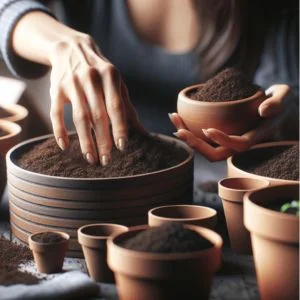What type of soil is needed for an indoor vertical garden

Introduction
Whether you’re a seasoned plant enthusiast or a complete novice, the charm of growing flourishing greenery indoors is undeniable.
In this article, we’ll explore the importance of choosing the right soil for your indoor vertical garden and the various benefits it offers.
Answer to the Question
What type of soil is needed for an indoor vertical garden?
The ideal soil for an indoor vertical garden should possess specific characteristics to support the growth of plants in a vertical arrangement.
Let’s look at the essential qualities that make soil suitable for this unique gardening method.
Benefits of Choosing the Right Soil
1. Proper Nutrient Retention
Choosing the right soil for your indoor vertical garden is crucial for ensuring proper nutrient retention.
Nutrient retention is the soil’s ability to hold onto essential elements that are vital for the healthy growth of plants.
By selecting a soil that excels in retaining nutrients, you provide your vertical garden with the foundation for optimal plant vitality and flourishing.
- Increased Nutrient Availability: High-quality soil enhances the availability of essential nutrients, such as nitrogen, phosphorus, and potassium, which are fundamental for plant growth and development.
- Microbial Activity: The right soil composition promotes beneficial microbial activity, creating a thriving environment for nutrient cycling and absorption by plants.
- Organic Matter and Humus: Soil that retains nutrients effectively is rich in organic matter and humus, providing a steady supply of nourishment to the plants in your vertical garden.
2. Adequate Drainage and Aeration
The benefits of selecting suitable soil extend to the provision of adequate drainage and aeration, crucial for the successful cultivation of plants in a vertical garden.
Optimal soil composition ensures that excess water can drain effectively while also allowing for sufficient air circulation, promoting robust plant growth.
It’s important to note that some plants can grow without soil, using methods such as hydroponics.
- Enhanced Root Health: The right soil composition provides an environment where roots can thrive, leading to healthier plants and improved nutrient absorption.
- Prevention of Waterlogging: Proper drainage helps prevent waterlogging, which can cause root rot and other detrimental effects on plant health.
- Regulation of Air Circulation: Adequate aeration in the soil regulates the flow of oxygen to the roots, supporting overall plant vigor and development.
3. pH Balance Maintenance
A key benefit of choosing the right soil for your indoor vertical garden is the maintenance of pH balance. Well-suited soil helps regulate the pH levels, creating an environment conducive to the healthy development of a diverse range of plants, each with distinct pH requirements.
Types of Soil Suitable for Indoor Vertical Gardens
1. Potting Mixtures
Potting mixtures are an excellent choice for indoor vertical gardens, offering a balanced combination of organic matter and essential nutrients.
Their lightweight nature makes them ideal for vertical arrangements and ensures efficient water retention.
- They are specifically formulated for container gardening and are well-suited for plants in confined spaces.
- Potting mixtures are designed to provide good aeration, drainage, and moisture retention, which are essential for healthy root development.
- These mixtures can include components such as peat moss, coconut coir, perlite, vermiculite, compost, and other organic materials, providing a diverse blend that supports plant growth.
- Some potting mixtures may also contain slow-release fertilizers, ensuring that plants receive a consistent supply of nutrients over time.
- It’s important to choose the right potting mixture based on the specific needs of the plants being grown, taking into consideration factors such as water requirements, nutritional needs, and root structure.
2. Peat Moss-based Soil
Peat moss-based soil is renowned for its exceptional water retention properties, making it a suitable option for indoor vertical gardens.
With its ability to retain moisture, this type of soil promotes consistent hydration for plants in a vertical arrangement.
3. Coco Coir
- Coco coir, also known as coconut fiber, is a natural byproduct derived from the husks of coconuts.
- It is valued for its sustainability and eco-friendly nature, making it an excellent choice for environmentally conscious gardeners.
- The fibrous texture of coco coir provides a stable structure that promotes optimal root growth and development.
- Due to its high water retention capacity, coco coir helps maintain consistent moisture levels within the soil, reducing the frequency of watering.
- It is naturally resistant to bacterial and fungal growth, contributing to a healthier growing environment for plants.
4. Vermiculite and Perlite Mix
A blend of vermiculite and perlite offers a lightweight and well-draining soil mix, making it an ideal choice for indoor vertical gardens.
This mixture promotes optimal water drainage and aeration, fostering a conducive environment for plant growth.
- Enhanced Drainage: Vermiculite and perlite blend facilitates superior water drainage, preventing waterlogged soil and root rot.
- Improved Aeration: The airy structure of this mix ensures adequate oxygen levels in the soil, promoting healthy root development.
- Moisture Retention: While promoting drainage, this mix also retains essential moisture, ensuring a consistent water supply for plants.
- Temperature Regulation: It provides insulation and reduces temperature fluctuations, creating a more stable environment for plant roots.
- Nutrient Enhancement: Vermiculite and perlite mix can be amended with nutrients or fertilizers, enhancing the soil’s nutrient-holding capacity.
In Conclusion
Choosing the right soil is paramount for the success of your indoor vertical garden.
By prioritizing soil with optimal nutrient retention, drainage, aeration, and pH balance maintenance, you can create an environment where plants thrive in a vertical setting.
With an array of suitable soil types available, you have the opportunity to craft a flourishing indoor vertical garden that adds beauty and greenery to your living space.

